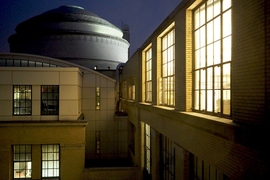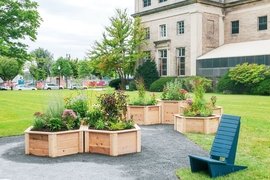Like most offices across MIT, the Office of Sustainability (MITOS) has in recent months worked to pivot projects while seeking to understand and participate in the emergence of a new normal as the result of the Covid-19 pandemic. Despite now working off campus, the MITOS team methodology — one that warrants collective engagement, commitment to innovative problem solving, and robust data collection — has continued.
An expanded look at resiliency
When the MIT community transitioned off campus, many began to use the word “resilient” for good reason — it’s one way to describe a community of thousands that quickly learned how to study, research, work, and teach from afar in the face of a major disruption. In the field of sustainability, resiliency is frequently used when referring to how communities can not only continue to function, but thrive during and after flooding or extreme heat events as the result of climate change.
In recent months, the term has taken on expanded meaning. “The challenges associated with Covid-19 and its impact on MIT and the greater community has provided a moment to explore what a sustainable, resilient campus and community looks like in practice,” says Director of Sustainability Julie Newman.
The MIT campus climate resiliency framework codified by MITOS — and in response to a changing climate — has long been organized around the interdependencies of four core systems: community (academic, research, and student life), buildings, utilities, and landscape systems. This same framework is now being applied in part to the MIT response to Covid-19. “The MIT campus climate resiliency framework has enabled us to understand the vulnerabilities and capacities within each core system that inhibit or enable fulfillment of MIT’s mission,” explains Brian Goldberg, MITOS assistant director. “The pandemic’s disruption of the community layer provides us with a remarkable test in progress of this adaptive capacity.”
The campus response to the pandemic has, in fact, informed future modeling and demonstrated how the community can advance its important work even when displaced. “MIT has been able to offer countless virtual resources to maintain a connected community,” Goldberg explains. “While a future major flood could physically displace segments of our community, we’ve now seen that the ability to quickly evacuate and regroup virtually demonstrates a remarkable adaptive capacity.”
Taking the hive home
Also resilient are the flowering plants growing in the Hive Garden — the Institute’s student-supported pollinator garden. Maintained by MIT Grounds Services alongside students, the closure of campus meant many would miss the first spring bloom in the new garden. To make up for this, a group of UA Sustainability Committee (UA Sustain) students began to brainstorm ways to bring sustainable gardening to the MIT community if they couldn’t come to campus. Working with MITOS, students hatched the idea for the Hive@Home — a project that empowers students and staff to try their hands (and green thumbs) at growing a jalapeno or two, while building community.
“The Hive@Home is designed to link students and staff through gardening — continuing to strengthen the relationships built between MIT Grounds and the community since the Hive Garden started,” says Susy Jones, senior project manager who is leading the effort for MITOS. With funding from UA Sustain and MindHandHeart, the Hive@Home pilot launched in April with more than four dozen community members receiving vegetable seeds and growing supplies. Now the community is sharing their sprouts and lessons learned on Slack with guidance from MIT Grounds experts like Norm Magnusson and Mike Seaberg, who helped bring the campus garden to life, along with professor of ocean and mechanical engineering Alexandra Techet, who is also an experienced home gardener.
Lessons learned from Covid-19 response
The impacts of Covid-19 continue to provide insights into community behavior and views. Seeing an opportunity to better understand these views, the Sustainability Leadership Committee, in collaboration with the Office of Sustainability, the Environmental Solutions Initiative, Terrascope, and the MIT Energy Initiative, hosted a community sustainability forum where more than 100 participants — including staff, students, and faculty — shared ideas on how they thought the response to Covid-19 could inform sustainability efforts at MIT and beyond. Common themes of human health and well-being, climate action, food security, consumption and waste, sustainability education, and bold leadership emerged from the forum. “The event gave us a view into how MIT can be a sustainability leader in a post Covid-19 world, and how our community would like to see this accomplished,” says Newman.
Community members also shared a renewed focus on the impacts of consumption and single-use plastics, as well as the idea that remote work can decrease the carbon footprint of the Institute. The Sustainability Leadership Committee is now working to share these insights to drive action and launch new ideas with sustainability partners across campus.
These actions are just the beginning, as plans for campus are updated and the MIT community learns and adapts to a new normal at MIT. “We are looking at these ideas as a starting place,” explains Newman. “As we look to a future return to campus, we know the sustainability challenges and opportunities faced will continue to shift thinking about our mobility choices, where we eat, what we buy, and more. We will continue to have these community conversations and work across campus to support a sustainable, safe MIT.”










